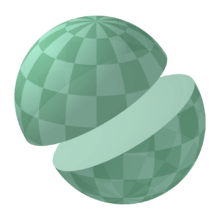Riemannian circle

In metric space theory and Riemannian geometry, the Riemannian circle (named after Bernhard Riemann) is a great circle equipped with its great-circle distance. In more detail, it is the circle equipped with its intrinsic Riemannian metric of a compact 1-dimensional manifold of total length 2π, as opposed to the extrinsic metric obtained by restriction of the Euclidean metric to the unit circle in the plane. Thus, the distance between a pair of points is defined to be the length of the shorter of the two arcs into which the circle is partitioned by the two points.
Properties
The diameter of the Riemannian circle is π, in contrast with the usual value of 2 for the Euclidean diameter of the unit circle.
The inclusion of the Riemannian circle as the equator (or any great circle) of the 2-sphere of constant Gaussian curvature +1, is an isometric imbedding in the sense of metric spaces (there is no isometric imbedding of the Riemannian circle in Hilbert space in this sense).
Gromov's filling conjecture
A long-standing open problem, posed by Mikhail Gromov, concerns the calculation of the filling area of the Riemannian circle. The filling area is conjectured to be 2π, a value attained by the hemisphere of constant Gaussian curvature +1.
References
- Gromov, M.: "Filling Riemannian manifolds", Journal of Differential Geometry 18 (1983), 1–147.